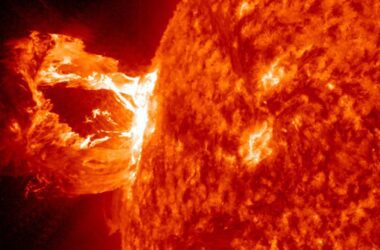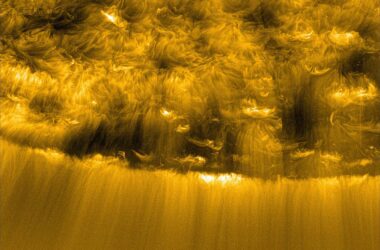Young star V960 Mon is surrounded by giant yellow spiral arms of dusty material in this image created by data from the SPHERE instrument, while the ALMA telescope reveals clumps (coloured blue) that could contract and collapse to form giant planets
ESO/ALMA (ESO/NAOJ/NRAO)/Weber et al.
This snapshot shows V960 Mon, a young star surrounded by huge cosmic dust arms. These arms might collapse and become gas giants like Jupiter.
Planets originate through core accretion and gravitational instability. Solid matter surrounding a star collides and forms a planet during core accretion.
However, gravitational instability causes gas and dust to form clumps that collapse and create a planet’s core. This process occurs further from the host star than core accretion, when dust and gas are colder. Thus, gravitational instability causes gas giants to arise.
There has been no observable evidence of how gravitational instability forms planets until now.
Philipp Weber and his colleagues at the University of Santiago, Chile, used the European Southern Observatory’s Very Large Telescope’s Spectro-Polarimetric High-contrast Exoplanet Research (SPHERE) instrument to capture the planet-forming process.
“No one had ever seen a real observation of gravitational instability happening at planetary scales – until now,” Weber added.
V960 Mon is 5000 light years from Earth in Monoceros, the Greek word for unicorn. An active star, it generates tremendous gas jets that form massive spiral arms larger than our solar system.
Weber and his team reviewed ALMA observations of V960 Mon. The spiral arms are fragmenting into gas and dust clumps. Gravitational instability precedes planet formation.
FAQs
Q1: What does the snapshot show around the young star V960 Mon?
A1: The snapshot reveals V960 Mon surrounded by huge cosmic dust arms, which have the potential to collapse and form gas giants similar to Jupiter.
Q2: How do planets typically originate?
A2: Planets can form through two main processes: core accretion, where solid matter surrounding a star collides and forms a planet, and gravitational instability, which causes gas and dust clumps to collapse and create a planet’s core.
Q3: How does gravitational instability lead to the formation of gas giants?
A3: Gravitational instability occurs further from the host star, where dust and gas are colder. It causes gas and dust to form clumps that collapse and give rise to gas giants.
Q4: What technology was used to capture the planet-forming process?
A4: Philipp Weber and his team used the European Southern Observatory’s Very Large Telescope’s Spectro-Polarimetric High-contrast Exoplanet Research (SPHERE) instrument to capture the process of planet formation around V960 Mon.
Q5: Where is V960 Mon located, and what makes it unique?
A5: V960 Mon is situated 5000 light years from Earth in Monoceros, and it stands out with its active star generating tremendous gas jets forming massive spiral arms larger than our solar system.







